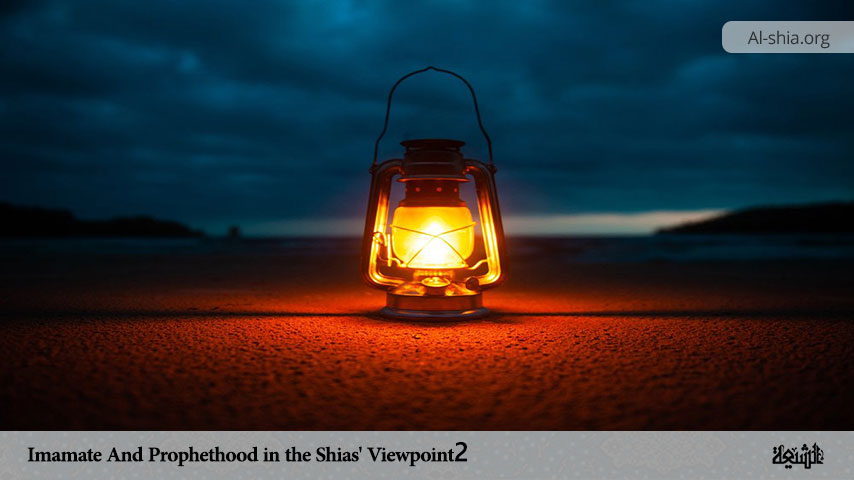In this part of the article titled “Imamate And Prophethood in the Shias’ Viewpoint”, we shall discuss other relevant points such as the appearance of Imam Mahdi and inspiration of the Imams.
The appearance of Imam Mahdi (PBUH)
Shia Muslims and Sunnis have narrated in their authentic books that when Imam Mahdi (PBUH) comes, Prophet Jesus (PBUH) will descent and will pray behind him. This clearly shows that the rank of Imam Mahdi (PBUH) is higher than that of Prophet Jesus who was one of the five greatest messengers of Allah.
It is narrated in Sahih Muslim that: Jabir Ibn Abdillah al-Ansari said: I heard the Messenger of Allah saying: “A group of my Ummah will fight for the truth until near the day of judgment when Jesus, the son of Marry, will descend, and the leader of them will ask him to lead the prayer, but Jesus declines, saying: “No, Verily, among you Allah has made leaders for others and He has bestowed his bounty upon them.” (1).
– Musnad, by Abu Ya’ala which provides another version of the tradition with more clear words on the authority of Jabir that the Messenger of Allah (PBUH&HP) said: “A group among my Ummah will continue to fight for the truth until Jesus, the son of Marry, will descend, and the Imam of them will ask him to lead the prayer, but Jesus replies: “You have more right to it and verily Allah has honored some of you over others in this Ummah.”
Ibn Abu Shaybah, another Sunni traditionist, and the mentor of al-Bukhari and Muslim, has reported several traditions about Imam al-Mahdi (PBUH). He has also reported that the Imam of the Muslims who will lead Prophet Jesus in prayer is Imam al-Mahdi himself. Jalaluddin al-Suyuti mentioned that: “I have heard some of the deniers of (truth) deny what has been conveyed about Jesus that when he descends will pray the Fajr prayer behind al-Mahdi. They say, Jesus has higher status than to pray behind a non-Prophet. This is a bizarre opinion since the issue of prayer of Jesus behind al-Mahdi has been proven strongly via numerous authentic traditions from the Messenger of Allah, who is the most truthful.” And then al-Suyuti goes on narrating some of the traditions in this regard (2).
Also al-Hafiz Ibn Hajar al-Asqalani mentioned that: “The Mahdi is of this Ummah, and that Jesus (PBUH) will come down and pray behind him.”(3) This is also mentioned by another scholar, Ibn Hajar al-Haythami, who wrote: “The Ahlul-Bayt are like the stars through whom we are guided in the right direction, and if the starts are taken away (or hidden) we would come face to face with the signs of the Almighty as promised (i.e., the Day of Resurrection). This will happen when the Mahdi will come, as mentioned in the traditions, and the Prophet Jesus will say his prayers behind him, the Dajjal will be slain, and then the signs of the Almighty will appear one after another.” (4)
All these clearly show that the rank of Imam Mahdi (PBUH) is higher than that of Prophet Jesus (PBUH) who was one of the five greatest messengers of Allah.
Are the Imams Inspired?
There is no doubt that when the verse: “Today I have perfected your religion and completed my bounty upon you, and I was satisfied that Islam be your religion.” (5), the religion is completed. Allah revealed Quran as well as the Shari’ah (Divine law) only to the Prophet (PBUH&HF), and none of such things was revealed to Imam Ali (PBUH). If Imam Ali was inspired (ILHAM), it had nothing to do with religious commandments; it was rather about what happened and what will happen.
There are many methods that Allah may inform His servants of something. One way is revelation (WAHY). The other way is inspiration (ILHAM). By inspiration, Allah induces the knowledge into the heart of His servant. This is unanimously held by the all the Islamic Schools. But do you really think revelation (WAHY) is only for the prophets and the messengers? If yes, then you have contradicted Quran, for Quran confirms that Allah sent revelation (WAHY) to the mother of Moses. The mother of Moses was neither a prophet nor a messenger. Agreed? Allah revealed to her to leave her son in the river so that Pharaoh’s soldier could take it to the Palace: And We REVEALED to the mother of Moses: Suckle (thy child) but when thou hast fears about him cast him into the river but fear not nor grieve: for We shall restore him to thee and We shall make him one of Our apostles. (6)
Notice that Quran straight forwardly uses the word WAHY (revelation). Here, Yusuf Ali has translated the word WAHY into inspiration. But Quran uses WAHY (revelation), and not ILHAM (inspiration). WAHY and ILHAM are two different things. However one thing which is clear is that the revelations to those who were neither prophet nor messenger, did not have anything to do with Shari’ah (divine law). It did not have anything to do with religious practices etc. Rather, It was an order to what way to choose at the time of confusion and/or informing what has happened or what will happen. So we can conclude that even revelation has different types. Only the revelation to Prophets and messengers is related to Shari’ah (divine law) and new religious practices, while others do not receive this type of revelation.
Remark: Quran also uses the word WAHY for non-human beings, but I am not concerned about that. I was focusing on different types of WAHY for human being only.
About our Imams:
There are twelve Imams (Guides) after Prophet Muhammad (PBUH&HF). Prophet mentioned that the number of his successors are twelve, and al-Bukhari, Muslim, Tirmidhi, Ahmad, … recorded that. The first of them, Imam Ali, got his knowledge of religion and the Divine Laws from Prophet Muhammad directly. Later Imams got it from the preceding Imams. There was no revelation of Divine Law (concerning oneself or people) after Prophet Muhammad (PBUH&HF). Allah may inform something to his appointed Imam, but the information is not any how related to Divine Law since the religion is complete. The information is only related to what happened and what will happen.
Do Imams Meet Angels
Also, according to Quran, talking to angels is NOT exclusive to prophets and messengers. Allah mentioned in Quran that Mary (the mother of Jesus) talked to angels, and angels talked to him. Look at Quran, to see the conversation of Mary and the angels: “Behold! the angels said “O Mary! Allah gives you glad tidings of a Word from Him: his name will be Christ Jesus the son of Mary held in honor in this world and the Hereafter and of (the company of) those nearest to Allah.(7) There is a whole conversation between Mary and the angel. See a couple of verses before and after the above verse. Mary (PBUH) was neither a prophet nor a messenger, yet she talked to angels. However the communication of Mary with angels had nothing to do with Shari’ah (Divine Law). It did not have anything to do with religious practices. Rather it was a news to what is about to happen, and instructions of what to do.
In this connection, also see verses (11:69-73) where angels talked to the wife of Abraham and gave her the glad tiding that she is pregnant of prophet Isaac (PBUH). Even Sunnis claim that Imran Ibn al-Husayn al-Khuza’i (d. 52/672) who was one of the companions of the Prophet Muhammad (PBUH&HF), was VISITED by angels, greeted by angels, SHOOK HANDS with angels and saw them, only being left by them for a short period after which the angels returned to him till the end of his life.(8)
There is no shadow of doubt that Imam Ali (PBUH) was “Muhaddath” which means “a person who has been spoken to”. Not only him, but also, all the twelve Imams as well as Lady Fatimah (PBUH) were Muhaddath/Muhaddathah. Based on the authentic Sunni traditions, it is narrated by Abu Huraira and Aisha that: The Prophet (PBUH&HP) said, “Amongst the people preceding you there used to be ‘Muhaddathun’ (i.e. persons who can guess things that come true later on, like those persons have been inspired by a divine power), and if there are any such persons amongst my followers, it is …”(9).
Narrated Abu Huraira: Allah’s Apostle said, “Among the nations before you there used to be people who were inspired (though they were not prophets). And if there is any of such a persons amongst my followers, it is …”. Narrated Abu Huraira: The Prophet said, “Among the nation of Bani Israel who lived before you, there were men who used to be inspired with guidance though they were not prophets, and if there is any of such persons amongst my followers, it is …”.
Also:
The Messenger of Allah (PBUH&HF) said: “Verily among the nations before your time there have been Muhaddathoon (those who have been spoken to), and if there is one among my people it is …” Also the
Messenger of Allah said: “Verily among the Children of Israel before your time there have been men who have been spoken to (rijalun yukallamoon) who were NOT prophets and if there is one among my people
it is …”(10).
NOTE: The name of the companion of the Prophet mentioned in the above traditions was deleted since his being Muhaddath is not confirmed by the Shia. Concerning the opinion of the Shia see al-Ghadir, by al-Amini, vol. 5, pp 42-54, vol. 8, pp 90-91.
It is mentioned in the above Sunni commentaries that the meaning of Muhaddath here is a person who is divinely inspired, who meets the angels and is spoken to by them, and who is informed of the news of Ghayb (not to be confused with the knowledge of Ghayb which belongs to Allah only) which is the information about the present time and the future, and that the companions who are mentioned in those traditions had these attributes!!! The conclusion is that the existence of Muhaddathoon (those who are spoken to) is a matter attested by all Muslims and that it is not something contrary to the fundamentals of Islam. The above Sunni documents also give evidence to the fact that Muhaddathoon are not prophets and they did not bring Shari’ah (divine law) from Allah to people.
Here are the definitions of messenger, prophet, and Imam:
1. A Prophet (Nabi) is a person to whom the Divine Law (Shari’ah) descends; this divine law may be concerned with beliefs (`aqa-id) or with practical activities (Ibadat, like prayer). This Divine Law either deals with the Nabi’s OWN life or with that of his community; or both. This is the fundamental definition of prophethood, though the prophet may also be informed of other things. The descent of the Divine Law (Shari’ah) may be direct, or through an intermediary like an angel.
2. A Human Messenger/Apostle (Rasul) is a Prophet who receives a Divine Law that concerns himself AND people other than himself.
3. Imam means a person who is appointed by God as a leader and as a guide(11) to whom obedience is due, and whom people should follow. Messengers are Warners and Imams are Guides.(12) Imams are the Stars of Guidance.(13) It is also interesting to remark about the time when the verse of the completeness of religion was revealed. It should be quite surprising that many Sunni scholars of Tafsir have confirmed that the verse: “Today I have completed your religion and my bounty upon you, and I was satisfied that Islam be your religion”(14) Was revealed in Ghadir Khum when the Messenger of Allah declared his successor.
Some of Sunni references which mentioned the revelation of the above verse of the Quran in Ghadir Khum after the speech of the Prophet:
(1) al-Durr al-Manthur, by al-Hafiz Jalaluddin al-Suyuti, vol. 3, p19
(2) Tarikh, by Khatib al-Baghdadi, vol. 8, pp 290, 596 from Abu Hurayra
(3) Manaqaib, by Ibn Maghazali, p. 19
(4) History of Damascus, Ibn Asakir, vol. 2, p. 75
(5) al-Itqan, by al-Suyuti, vol. 1, p. 13
(6) Manaqib, by Khawarazmi al-Hanfi, p. 80.
(7) al-Bidayah wal-Nihayah, by Ibn Kathir, vol. 3, p. 213
(8) Yanabi’ al-Mawaddah, by al-Qudoozi al-Hanafi, p. 115
(9) Nuzul al-Quran, by al-Hafiz Abu Nu’aym narrated on the authority Abu Sa’id Khudri.
… and more.
To be continued!
NOTES:
________________________
1. Sahih Muslim, Arabic, part 2, p. 193; Musnad Ahmad Ibn Hanbal, vol. 3, pp 45, 384; Sawa’iq al-Muhriqah, by Ibn Hajar al-Haythami, p. 251* Nuzul Isa Ibn Maryam Akhir al-Zaman, by Jalaluddin al-Suyuti, p. 57.
2. Nuzool Isa Ibn Maryam Akhir al-Zaman, by Jalaluddin al- Suyuti, p. 56.
3. Sunni reference: Fat’h al-Bari, by Ibn Hajar al-Asqalani, vol. 5, p. 362
4. Sunni reference: Sawa’iq al-Muhriqah, by Ibn Hajar al-Haythami, Ch 11, p. 91
5. Qur’an 5:3.
6. Qur’an 28:7.
7. Qur’an 3:45.
8. Sahih Muslim, Vol. 4, pp 47-48; Also commentaries of Sahih Muslim by al-Nabawi, Vol. 8, P. 206; and by al-Abi and al-Sanusi, Vol. 3, P. 361; Musnad Ahmad Ibn Hanbal, Vol. 4, PP 427-428; Sunan Darimi, Vol. 2, P 305; al-Mustadrak, by al-Hakim, Vol. 3, P. 472; Tabaqat, by Ib Sa’d, Vol. 7, part 1, P6; al-Isti’ab, by Ibn Abd al-Barr, Vol. 3, P. 1208; Usdul Ghabah, by Ibn Athir, Vol 4, P138; Jami’ul Usul, by Ibn Athir, Vol 7, P. 551; al-Isabah, by Ibn Hajar al-Asqalani, Vol. 3, PP 26-27; Tahdhib al-Tahdhib, by Ibn Hajar al-Asqalani, Vol. 8, P. 126; Fathul al-Bari, by Ibn Hajar al-Asqalani, Vol. 12, P. 261; Sharh al-Mawahib, by al-Qastalani, Vol. 7, P. 133.
9. Sahih al-Bukhari Hadith: vol. 5.38 (Arabic-English Version)
10. Sahih al-Bukhari, Arabic version, vol. 4, p. 211, vol 5, p. 15, and also its commentaries:- Fat’h al-Bari, by Ibn Hajar al-Asqalani, vol. 7, p. 324, vol. 8, pp 49-51; Umdatul Qari, by al-Ayni, vol. 16, pp 55, 198-199; Irshad al-Sari, by Qastalani, vol. 6, p. 103; Sahih Muslim, Arabic version, part 7, p. 115, and its commentaries: – Sharh Nawawi (sahih Muslim), part 15, p. 166; Sharh al-Abi, part 6, pp 203-205; Sahih al-Tirmidhi, vol. 5, p. 622, and its commentaries: Aridah al-Ahwadhi, by Ibn al-Arabi, vol. 13, pp 149-150; Tuhfah al-Ahwadhi, by al-Mubarak Furi, vol. 10, pp 182-183; Musnad Ahmad Ibn Hanbal, vol. 6, p. 55.
11. See Qur’an 21:73 and 32:24.
12. Qur’an 13:7.
13. Qur’an 6:97.
14. Qur’an 5:3.


















